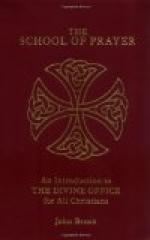The general rubrics are divided into thirty-seven Titles. Attention will be given to each; of these Titles, some of which must be modified by recent legislation. The order followed may not be the order followed in the general rubrics as given in the Breviary, as matters treated in the general rubrics found in the Breviary are treated under other headings here. However, a look at the table of contents or at the index shows the pages treating of these Titles.
TITLE I. THE DOUBLE OFFICE.
“Consequently, the civilised peoples already in remote antiquity have found a call to the worship of God in the changing seasons and times and so have introduced sacred seasons. Sacred times and places are common to all religions in general. The change of times bringing with them corresponding changes in nature made a religious impression upon mankind. In turn, man sanctified certain times and dedicated them to God, and these days, thus consecrated to God, became festivals.”
The entire number of ecclesiastical holydays and seasons is codified for us in the different Church calendars. Their contents fall into two essentially different divisions, each possessing an entirely different origin and history. The first division consists of festivals of our Lord, distributed over the year, regulated and co-ordinated in accordance with certain laws. The second division consists of commemorations of saints in no wise connected with festivals of our Lord or with one another. Occupying to some extent an intermediate position between these two chief divisions come the festivals of our Blessed Lady, which have this in common with the festivals of the saints, that they fall on fixed days; but, on the other hand, they are to a certain extent connected with each other and with some feasts of our Lord. This is carried out in such a way that they are distributed throughout the Church year and are included in each of the festal seasons (Kellner, Heortology, Part I.).
From Apostolic times the feasts of Easter, the Ascension and Pentecost were celebrated. In the second century feasts of the Apostles were celebrated and the cult of the Martyrs was of speedy and widespread development. But it was not, probably, till the fourth century, that the feasts of saints who were not martyrs were celebrated.
Origin of the different grades of feasts. To-day, we find Church festivals arranged in three grades, doubles, semi-doubles and simples, and it is very difficult, to determine clearly and accurately the origin and the nature of the arrangements. But from the works of scholars, who have studied this matter, the following may be considered as a fair and accurate summing up:—




